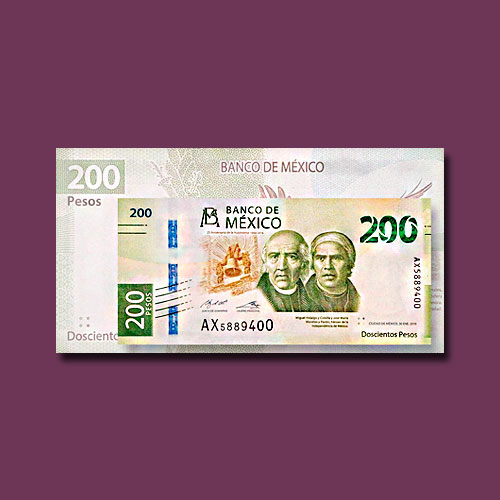Mexico Issues New 200-peso Note
2019-09-16 Mon
Mexico released a new 200-peso on 2nd September without the portrait of Sister Juana Ines de la Cruz. Sister Juana was a famous 17th Century writer whose portrait featured on Mexican banknotes for the first time in 1978. The portrait first appeared on 1,000-peso and was also shown on the 200-peso notes that were released in 1993. The new green-coloured note is made of cotton and has the dimensions 139 by 65 millimetres.The obverse side honours two significant freedom fighters of Mexico. One of them was a priest named Miguel Hidalgo y Costilla who led a rally called “el grito de Dolores” or the “Cry of Dolores”, on 16th September 1810. Jose Maria Morelos y Pavon’s portrait is also depicted alongside. It was Jose Maria who led the independence movement after Hidalgo’s death. He is popularly known as the “Siervo de la Nación” (Servant of the Nation). The vignette shows “Campana de Dolores” (Bell of Dolores), which was used to call the protestors in Dolores Hidalgo.
The reverse side depicts a flying royal eagle over Pinacate biosphere reserve in Sonora state. It is Mexico’s scrubland and desert ecosystem, with volcanic as well as dune systems. It was listed as a World Heritage Site by UNESCO in 2003. The El Elegante is the largest volcanic crater in the area which is 1 mile wide 656 feet deep. The crater was formed somewhere between 5 million and 150,000 years ago. Apart from historic craters like these, 560 plant species, some of the world’s largest cacti, 40 species of mammals, 200 bird species, and 40 reptiles are also protected in this reserve.
The new notes will circulate along with the old ones. The new ones will feature the text 25 ANIVERSARIO DE LA AUTONOMIA 1994–2019 (25th Anniversary of Autonomy 1994–2019), indicating the Mexican Constitution’s amendment, after which Bank of Mexico was termed as an autonomous institution.
Image Courtesy: Bank of Mexico
Latest News
-
Janma Kalnayak of Bhagwan Mahavir
2024-04-24 WedOn 21st April 2024 which was the 2550th Janma Kalnyanak of Bhagwan Mahavir Swami, PM Modi unveile...
-
Gold Pagoda of Vijaynagar Empire King Deva Raya I
2024-04-10 WedKing Deva Raya I of the Vijayanagara Empire was a patron of Kannada literature and architecture. He ...
-
Silver Denarius of Septimus Severus
2024-04-05 FriLucius Septimius Severus served as the Roman emperor from 193 to 211 AD. Severus sat on the throne o...
-
Extremely rare 'Malaharamari' type Gold Gadyana of King Guhalladeva-III Sold for INR 611000
2024-04-03 WedTribhuvanamalla, also known as Guhalladeva III, was the ruler of the Kadamba dynasty. His reign coin...
-
90 Years of RBI
2024-04-02 TueOn 1st April, PM #Modi unveiled a special commemorative coin marking 90 Years since the foundation o...

